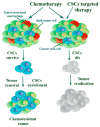Mechanisms of Chemotherapy Resistance in Triple-Negative Breast Cancer-How We Can Rise to the Challenge
- PMID: 31443516
- PMCID: PMC6770896
- DOI: 10.3390/cells8090957
Mechanisms of Chemotherapy Resistance in Triple-Negative Breast Cancer-How We Can Rise to the Challenge
Abstract
Triple-negative (TNBC) is the most lethal subtype of breast cancer owing to high heterogeneity, aggressive nature, and lack of treatment options. Chemotherapy remains the standard of care for TNBC treatment, but unfortunately, patients frequently develop resistance. Accordingly, in recent years, tremendous effort has been made into elucidating the mechanisms of TNBC chemoresistance with the goal of identifying new molecular targets. It has become evident that the development of TNBC chemoresistance is multifaceted and based on the elaborate interplay of the tumor microenvironment, drug efflux, cancer stem cells, and bulk tumor cells. Alterations of multiple signaling pathways govern these interactions. Moreover, TNBC's high heterogeneity, highlighted in the existence of several molecular signatures, presents a significant obstacle to successful treatment. In the present, in-depth review, we explore the contribution of key mechanisms to TNBC chemoresistance as well as emerging strategies to overcome them. We discuss novel anti-tumor agents that target the components of these mechanisms and pay special attention to their current clinical development while emphasizing the challenges still ahead of successful TNBC management. The evidence presented in this review outlines the role of crucial pathways in TNBC survival following chemotherapy treatment and highlights the importance of using combinatorial drug strategies and incorporating biomarkers in clinical studies.
Keywords: ABC transporters; Triple-negative breast cancer; apoptosis; cancer stem cells; chemoresistance; hypoxia; microRNA; molecular subtypes; receptor tyrosine kinases; signaling pathways.
Conflict of interest statement
The authors declare no conflict of interest.
Figures





References
Publication types
MeSH terms
Substances
LinkOut - more resources
Full Text Sources
Other Literature Sources
Medical

